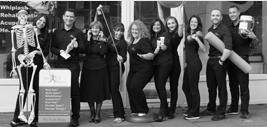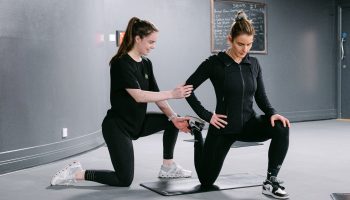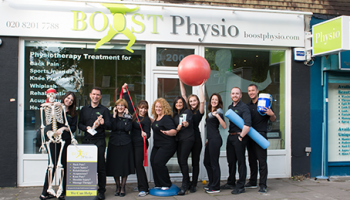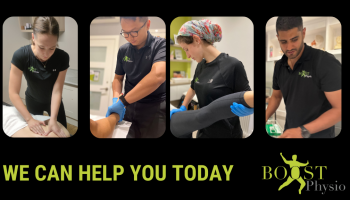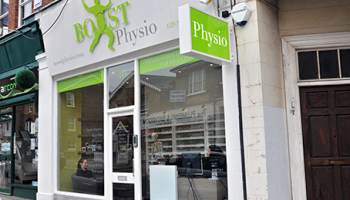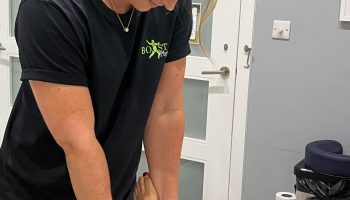Mr Mark Davies' opinion on Fit-Flops, bunions, runners and more!
BOOST PHYSIO asks leading foot and ankle surgeon Mr Mark Davies 4 topical questions in this Consultant Q&A feature.
Mr Davies is a Consultant Orthopaedic Surgeon and Clinical Director of the London Foot and Ankle Centre which is based at The Hospital of St John and St Elizabeth in St John’s Wood London NW8. He has a very impressive CV which can be viewed here.
BOOST PHYSIO: What is you view on trendy Fit-flops and MBT shoes?
Mr Mark Davies: When the MBT shoe came out it was a real revelation to me. The principal problem with them was that they were exceptionally ugly and some patients did topple over as a result of imbalance. Their cosmetic appearance has improved greatly but their marketing hasn’t, and I have to say that now I tend to recommend people Fit Flops over and above MBTs on the basis that they are stylish, extremely comfortable, and anybody can wear them whether they have a balance problem or not. In fact, I would go so far as to say
that the FitFlop has become my post-operative shoe when people come out of plaster or splintage.
BOOST PHYSIO: As a leading ankle and foot surgeon you have dealt with many high profile sports people- tell us about a memorable case.
Mr Mark Davies: For obvious reasons I cannot disclose the identity of the patients upon whom I have operated, but I have been involved with looking after many Premier League footballers, principally those based at Chelsea and Tottenham Hotspur. The cases that spring to mind are always those individuals who have had devastating injuries which would be devastating for any human being let alone an elite athlete. A fracture dislocation of the ankle can lead to major problems in any individual and therefore to operate on such an injury and see the player return to club and international duties without any restriction is always extremely rewarding. One also has to remember that these players have access to the best medical facilities in the world and without the physiotherapy input after this kind of surgery, they almost certainly wouldn’t do nearly as well.
BOOST PHYSIO: You use some innovative surgical techniques- give us an example of how this improves the outcome or recovery.
Mr Mark Davies: Surgeons are always coming up with innovative surgical techniques, often only to find that they are something that has been tried before and are not as good as first thought. The two techniques which I feel have revolutionised my practice in the last few years is the Achillon device for repairing Achilles tendons. This is a device that enables the sutures to be placed through the tendon through a very small incision and allows for a predictable and speedy recovery. It eliminates the risk of infection and sural nerve damage which were the main bugbears of open Achilles surgery, and although it is extremely simple, it is highly effective. The other technique which is becoming used more and more as an adjunct to other surgery, but also in isolation, is the gastrocnemius release for patients who have tight calf muscles. Over the years surgeons have failed to realise the significance of this pathology and many foot symptoms relate to it. By carrying out a tiny operation behind the knee to release the gastrocnemius muscle, many patients are saved from more extensive surgical procedures, and the recovery is fast.
BOOST PHYSIO: Certain conditions that you have to treat surgically are “self-inflicted” by patients, what are these conditions and culprits causing them?
Mr Mark Davies: As far as self-inflicted conditions are concerned, the main one has to be bunions, but one also has to remember that bunions form as a result of a hereditary tendency and there are some people who wear the most inappropriate shoes who never have any problems at all. However, many people do have a genetic predisposition to bunion formation and clearly high heeled and narrow shoes exacerbate this tendency. Over the years I have come to the conclusion that there is absolutely no point in trying to convince women not to wear high heels!
The other self-inflicted injuries are those in sports addicts who have a need, both physical and mental, to exercise. Many of the conditions such as Achilles tendinitis and plantar fasciitis are caused by these conditions, and if the patients were just able to back off and allow the early symptoms to settle they would be saving themselves an awful lot of trouble.
My coat of arms (a joke coat of arms) has the insignia Pedem Audi Noli Stultus Est, which means listen to your foot and don’t be daft! If people followed this rule, an awful lot of suffering would be avoided.
BOOST PHYSIO has had much experience and contact dealing with Mr Davies highly recommends him as an outstanding ankle and foot surgeon. His website is www.londonfootandanklecentre.co.uk
BOOST PHYSIO treats all sorts of ankle and foot injuries and problems, from simple sprained ankles to complex post-operative rehabilitation.

Ouch! Swelling and bruising after a twisted ankle indicates a Grade 2 injury which can take 6 weeks to heal.
BOOST PHYSIO has 2 high street physiotherapy clinics in North London (N2 East Finchley) and in North West London (Hendon NW4). We are open 8am-9pm and we also have appointments available on Sundays- view our clinics here.


Mon-Thurs 8am-9pm
Fri 8am-3pm
Sat/Sun 9am-6pm
BOOST PHYSIO works with major insurance companies like: BUPA, AVIVA, WPA, AXA. We usually deal directly with your insurance company.







